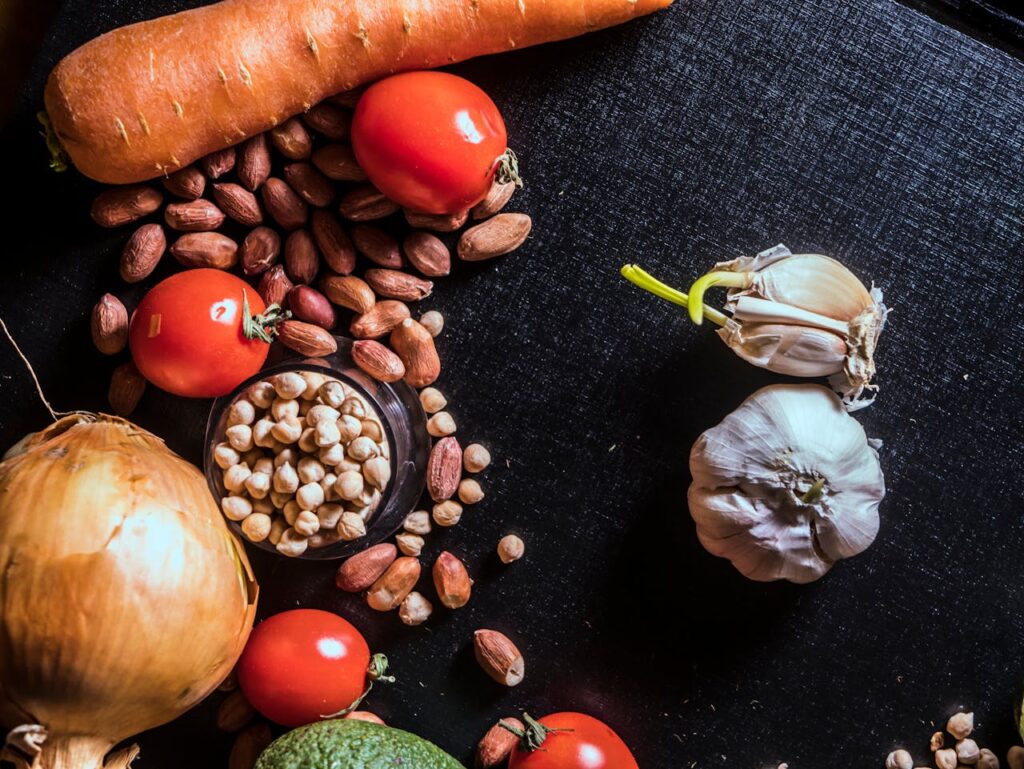
Explore & Play
Discover interesting topics and solve the accompanying crossword puzzle.
Food Crossword | Essential Cooking Ingredients
Table of Contents
Welcome to our guide on essential cooking ingredients! Before diving into the details, why not challenge yourself with our Food crossword puzzle? It’s a fun way to test your knowledge and familiarize yourself with the key terms we’ll be covering. If you’re new to the topic or want more context, feel free to read through the article first and then return to the crossword for a rewarding challenge. Enjoy exploring the world of cooking ingredients and see how many you already know!
Food Crossword
You can either fill in the crossword puzzle directly on this page or click the button in the bottom right corner to print it for free.

The Ultimate Guide to Essential Cooking Ingredients
In the world of cooking, the right ingredients can make all the difference between a meal that merely satisfies and one that truly delights. In this ultimate guide, we’ll explore essential cooking ingredients that every kitchen should have, weaving in interesting facts and tips along the way. Plus, test your knowledge with our food-themed crossword puzzle at the end!
1. Herbs and Spices: The Flavor Enhancers
Herbs and spices are the backbone of flavorful cooking, adding depth and complexity to dishes. Let’s delve into some of the most essential herbs and spices that can transform your culinary creations.
1.1. Basil: The Italian Favorite
Basil, often regarded as the cornerstone of Italian cuisine, brings a fresh, aromatic flavor to dishes. This herb is particularly famous for its role in pesto, a blend of basil, garlic, pine nuts, Parmesan cheese, and olive oil. Beyond pesto, basil enhances tomato sauces, salads, and even soups. Fresh basil is best used at the end of cooking to preserve its delicate flavor.
1.2. Dill: A Pickler’s Best Friend
Dill is renowned for its role in pickling, imparting a distinctive tangy flavor to cucumbers and other vegetables. This herb’s feathery leaves and seeds are both used in cooking. Dill complements fish dishes, creamy dips like tzatziki, and is a key ingredient in many Scandinavian recipes. When using dill, remember that it’s best added towards the end of cooking to maintain its flavor.
1.3. Cinnamon: Sweet and Spicy
Cinnamon is a spice that brings warmth and sweetness to both sweet and savory dishes. It’s a staple in baking, often used in cookies, cakes, and pies. Additionally, cinnamon adds a wonderful depth to stews and curries. This spice can also have health benefits, such as anti-inflammatory properties and potential blood sugar regulation. For a balanced flavor, use cinnamon in moderation to avoid overwhelming your dish.
1.4. Paprika: The Red Wonder
Paprika, made from ground dried peppers, ranges from sweet to hot. This spice is a vibrant addition to dishes, offering not only color but also a variety of flavors. Sweet paprika is commonly used in Spanish and Hungarian cuisine, while smoked paprika adds a smoky depth to meats and stews. To maximize its flavor, add paprika early in the cooking process, allowing it to infuse the dish fully.
1.5. Nutmeg: A Touch of Warmth
Nutmeg is a spice derived from the seed of the nutmeg tree and adds a warm, sweet flavor to baked goods and savory dishes alike. It is commonly used in pies, cakes, and custards, and also enhances creamy sauces and soups. Freshly grated nutmeg offers a more potent flavor compared to pre-ground nutmeg, so consider investing in a whole nutmeg and grating it as needed.
1.6. Oregano: An Italian Staple
Oregano is a key herb in Italian cuisine, known for its robust, earthy flavor. It pairs exceptionally well with tomatoes, making it a perfect addition to sauces, pizzas, and roasted vegetables. Oregano can be used fresh or dried, with dried oregano often having a more concentrated flavor. For the best results, add oregano towards the end of cooking to preserve its aroma and taste.
1.7. Garlic: The Aromatic Bulb
Garlic is an indispensable ingredient in many kitchens, known for its strong, aromatic flavor that can transform any dish. Whether minced, chopped, or roasted, garlic adds depth to sauces, soups, and stir-fries. Fresh garlic provides a more intense flavor compared to garlic powder or garlic salt. To mellow its sharpness, try roasting garlic to achieve a sweeter, more subtle taste.
1.8. Wasabi: The Spicy Kick
Wasabi, often mistaken for horseradish, is a pungent green paste that adds a sharp, spicy kick to sushi and other Japanese dishes. Fresh wasabi is a rare delicacy, so most wasabi available is a mixture of horseradish and green dye. Wasabi’s heat can quickly overpower a dish, so use it sparingly and mix it with soy sauce or other condiments to balance its intensity.
2. Essential Condiments and Sauces
Condiments and sauces are crucial for adding finishing touches to your dishes. Let’s explore some of the most popular and versatile sauces that can elevate your cooking.
2.1. Ketchup: The Classic Condiment
Ketchup, a tomato-based condiment, is a staple in many households. It pairs well with burgers, fries, and even as a base for barbecue sauces. Its sweet and tangy flavor makes it a versatile ingredient in various dishes. For a twist, try using ketchup in meatloaf or as a glaze for roasted meats to add a unique layer of flavor.
2.2. Mustard: From Smooth to Spicy
Mustard comes in various forms, from smooth yellow mustard to hot Dijon. Each type offers a different flavor profile, making it a versatile ingredient in cooking. Yellow mustard is often used in sandwiches and hot dogs, while Dijon mustard adds a sophisticated touch to salad dressings and marinades. Mustard can also be used to create homemade sauces and vinaigrettes.
2.3. Salsa: Fresh and Spicy
Salsa, a fresh tomato-based sauce with a variety of flavors, is a popular accompaniment for chips, tacos, and grilled meats. Salsa can be made with ingredients such as tomatoes, onions, cilantro, and chili peppers, and its heat level can be adjusted according to your preference. For a homemade touch, experiment with different types of tomatoes and add fruits like mango for a unique twist.
2.4. Caramel: Sweet and Sticky
Caramel is a sweet, sticky sauce made by melting sugar until it turns golden brown. It’s commonly used in desserts like caramel cakes, puddings, and ice cream sundaes. Making caramel at home requires careful attention to avoid burning the sugar, but the result is a rich, buttery flavor that enhances any dessert. For a smoother texture, incorporate cream into the caramel after it has been melted.
3. Vegetables and Fruits: The Nutrient Powerhouses
Incorporating a variety of vegetables and fruits into your diet not only adds flavor but also essential nutrients. Let’s look at some key vegetables and fruits that should be staples in your kitchen.
3.1. Broccoli: The Nutrient-Rich Green
Broccoli is a cruciferous vegetable packed with vitamins, minerals, and antioxidants. Its slightly bitter flavor and crisp texture make it a versatile ingredient in salads, stir-fries, and casseroles. To retain its nutritional value, consider steaming or roasting broccoli rather than boiling it. Adding a splash of lemon juice or a sprinkle of Parmesan cheese can enhance its flavor.
3.2. Eggplant: The Versatile Vegetable
Eggplant, also known as aubergine, is a versatile vegetable with a slightly bitter taste that mellows when cooked. It can be grilled, roasted, or sautéed, and is a key ingredient in dishes such as ratatouille and moussaka. To reduce its bitterness, salt the eggplant slices before cooking to draw out excess moisture and then rinse and pat dry.
3.3. Mango: The Tropical Delight
Mango is a tropical fruit known for its sweet, juicy flavor and vibrant color. It’s perfect for adding a tropical twist to salads, salsas, and desserts. When selecting mangoes, look for ones that yield slightly to gentle pressure. To prepare, cut the mango into slices or cubes, and enjoy its refreshing taste on its own or as part of a dish.
3.4. Radish: The Crunchy Kick
Radishes are small, crunchy vegetables with a peppery flavor that can add a delightful crunch to salads and sandwiches. They come in various colors and sizes, with the most common being red and round. Radishes can also be pickled or roasted to mellow their sharpness and bring out their natural sweetness.
3.5. Tomato: The Kitchen Essential
Tomatoes are a fundamental ingredient in many cuisines, valued for their juicy texture and tangy flavor. They can be used fresh in salads, cooked into sauces, or roasted to enhance their natural sweetness. To preserve tomatoes, consider making homemade tomato sauce or canning them for use throughout the year.
3.6. Olive: The Mediterranean Favorite
Olives are a staple in Mediterranean cuisine, known for their rich flavor and health benefits. They come in various types, including green and black, and can be enjoyed on their own or added to dishes like salads and tapenade. Olive oil, derived from olives, is a key ingredient in cooking and dressings, valued for its rich flavor and healthy fats.
4. Baking and Cooking Ingredients
Whether you’re baking or cooking, certain ingredients are essential for creating delicious and well-balanced dishes. Here’s a look at some key baking and cooking staples.
4.1. Vanilla: The Sweetener’s Secret
Vanilla is a popular flavoring derived from orchid beans. It’s used extensively in baking to enhance the flavor of cakes, cookies, and ice cream. Vanilla extract, made by soaking vanilla beans in alcohol, is the most common form, but vanilla beans provide a more intense flavor. For the best results, use high-quality vanilla and add it to your recipes to bring out a depth of flavor.
4.2. Tofu: The Meat Substitute
Tofu, made from soybean curd, is a versatile ingredient that serves as a meat substitute in many dishes. It has a mild flavor and can be prepared in various ways, including grilling, stir-frying, or blending into smoothies. Tofu is rich in protein and can absorb the flavors of the ingredients it is cooked with, making it a valuable addition to vegetarian and vegan diets.
4.3. Lard: The Traditional Fat
Lard, rendered pig fat, has been used in cooking and baking for centuries. It provides a rich flavor and flaky texture in pastries and is ideal for frying due to its high smoke point. While lard has fallen out of favor in modern times, it can still be used to achieve traditional textures in baking. If you’re looking for a substitute, consider using butter or vegetable shortening.
5. Cooking Techniques and Dishes
Mastering various cooking techniques can significantly enhance your culinary skills. Explore these essential techniques and popular dishes to elevate your cooking.
5.1. Sauté: The Quick and Flavorful Method
Sautéing is a cooking technique that involves quickly frying ingredients in a small amount of fat over high heat. This method is perfect for cooking vegetables and proteins, as it allows them to develop a rich flavor and texture while retaining their nutrients. Use a hot pan and keep the ingredients moving to achieve an even, golden-brown color.
5.2. Risotto: The Creamy Italian Classic
Risotto is a creamy Italian rice dish made by cooking arborio rice in a flavorful broth. The key to perfect risotto is to stir continuously and add the broth gradually, allowing the rice to release its starch and create a creamy consistency. Experiment with different ingredients like mushrooms, seafood, or vegetables to create your own variations.
5.3. Ravioli: Pasta Filled with Flavor
Ravioli are small pasta pockets filled with ingredients such as cheese, meat, or vegetables. They can be made fresh or bought pre-made and are often served with a variety of sauces. Homemade ravioli requires a bit of effort but results in a delicious and personalized dish. Serve with a simple tomato sauce or a rich cream sauce to complement the filling.
5.4. Fettuccine: The Ribbon Pasta
Fettuccine is a type of pasta that is wide and flat, making it ideal for pairing with creamy sauces. Classic fettuccine dishes include Fettuccine Alfredo, where the pasta is coated in a rich, buttery sauce made with cream and Parmesan cheese. To cook fettuccine perfectly, boil it in salted water until al dente and toss with your favorite sauce.
5.5. Lasagna: The Layered Dish
Lasagna is a hearty, layered dish made with sheets of pasta, meat sauce, and cheese. It’s baked until bubbly and golden, creating a comforting meal that can be made ahead of time and reheated. Traditional lasagna recipes include layers of Bolognese sauce and béchamel, but feel free to experiment with different fillings like vegetables or seafood.
5.6. Pickles: The Tangy Crunch
Pickles are cucumbers or other vegetables preserved in vinegar or brine. They provide a tangy, crunchy contrast to many dishes and can be enjoyed as a snack or side. Homemade pickles allow you to control the flavor and spice levels, and you can experiment with different types of pickling liquids and seasonings to create unique varieties.
Final Thoughts: Elevate Your Cooking with Essential Ingredients
By incorporating these essential ingredients into your cooking repertoire, you can elevate your meals and experiment with new flavors and techniques. From herbs and spices to baking essentials and classic dishes, understanding and using these ingredients effectively can transform your culinary creations. Challenge yourself with our food-themed crossword puzzle to test your knowledge of these key ingredients and their uses!
Share to...
I hope you enjoy the content.
Want to receive our daily crossword puzzle or article? Subscribe!
You may also be interested in
Share to…
Want to receive our daily crossword puzzle?
-
Jigsaw Puzzles
Majestic Horse Watercolor Jigsaw Puzzle 250 | 300 | 500 Pieces
kr 348,00 – kr 439,00Price range: kr 348,00 through kr 439,00 Select options This product has multiple variants. The options may be chosen on the product page -
Jigsaw Puzzles
Elegant Pig Zodiac Watercolor Jigsaw Puzzle 250 | 300 | 500 Brikker
kr 348,00 – kr 439,00Price range: kr 348,00 through kr 439,00 Select options This product has multiple variants. The options may be chosen on the product page -
Jigsaw Puzzles
Art Nouveau Jigsaw Puzzle with Betta Fish in Lush Garden Scene 250 | 300 | 500 Pieces
kr 348,00 – kr 439,00Price range: kr 348,00 through kr 439,00 Select options This product has multiple variants. The options may be chosen on the product page

















